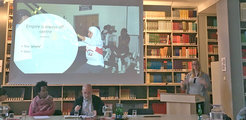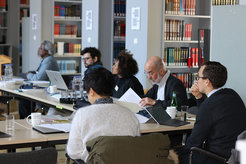Blog | December 2018
Off-Center Inquiry
by Derek Denman
I wish to reflect on the concept of “off-centeredness” invoked in the title of “Empire Off-Center” and evoked through participants’ interventions. The title implores us to reconsider the conjunction of space and power. Whereas empire would seem to be the quintessential “centering” entity—an enormous, extended geographic space, divided between the center of the metropole and the periphery of the colonies, and wielding imperium, a form of power characterized by command—“empire off-center” suggests a more complex relationship between space and power. How would an off-center inquiry unsettle this common sense understanding of empire as a centering, totalizing force? In what follows, I offer a few provisional reflections on the off-center as a method of critique.
We can approach the off-center by considering first what it means to be centered or, alternatively, concentric. A concentric image of power might be most clearly illustrated by the allegorical renderings of the radial city in late Renaissance art and architecture. Each ring of the city identified a political space that corresponded to a domain of moral or practical knowledge and provided a further barrier to questioning the mode of knowledge at the center. The outer enceinte represented geometry, providing the material form of urban defense, while the inner circle would house “higher” forms of knowledge, represented by Plato, Aristotle, or another prominent figure of philosophical antiquity. Each ring extends the reach of polity and further guards the central metaphysics. Following such a spatial imaginary, one might be tempted to understand empire as a ring encircling smaller scales of the state, city, household, and self. This is empire that encompasses all possible scales, the grand container space.

The interventions of the workshop approach empire in terms that refuse this concentric image. Empire is not a flat plane, a homogenous surface, or the container of all containers. Instead, it involves routes, circuits, and heterogeneous connections of power, or following Miloš Jovanović (drawing on Anthony Vidler), a “warped space.” Jovanović explores the displacements of empire enacted through the plunder of monument stones, rearranged in the gardens of the metropole, and the abduction of a young woman, held captive by a Habsburg field marshal in his garden simulacra. By viewing the space of empire through the perspective of the captive, Jovanović suggests “it is the metropole which appears exceptional, a warped emplacement of the periphery.”
This spatial, material, and epistemological remaking of the world by empire was also the focus of Priyamvada Gopal’s presentation. Quoting Fanon in The Wretched of the Earth, Gopal reminds us that “Europe is literally the creation of the Third World” (102). With this proclamation, Fanon calls attention to the scale of plunder under colonialism. Such theft entailed not only resources and commodities but also, as panelists of “Empire Off-center” detailed, monuments, flora and fauna, human beings, and even human remains. In naming the enormity of this extractive violence, Fanon also points to the ways in which the metropole has constituted itself, down to the level of “raw materials,” from the very substance of the colony (102). The colony is not peripheral but shot through, intersected by, and reassembled in the metropole. Such is the warped space of empire.

Gopal seeks to move beyond the material connections of empire and consider the ways in which colony and metropole are interwoven at the level of the creation of knowledge. Central to this concern was anti-colonial politics: How does one articulate conditions of freedom from colonial power in a world and discourse that is deeply—inextricably perhaps—intertwined with coloniality? Gopal turns to Aimé Césaire’s meditations on reason and his efforts to transform this concept that has been embedded in logics of control and the denial of agency to the colonized. Colonialism entailed not only the extraction of material resources and wealth but a kind of imperial plagiarism, appropriating numerous elements of non-European science, mathematics, philosophy, and law. In approaching empire off-center, Gopal calls for an anti-colonial politics that sees reason, science, and modernity not as the exclusive domain of “the West” but as a product that includes the labor, resources, and resistance of the colonized.
The “centering” force of empire might be captured best in J.M. Coetzee’s Waiting for the Barbarians when he suggests, “Empire has created the time of history … One thought alone preoccupies the submerged mind of Empire: how not to end, how not to die, how to prolong its era” (133). Empire works through an obsession with the infinite, clawing its way forward in a time that it names history, aspiring to contain the totality of existence, and insisting on its own order and centeredness. To suggest that empire is off-center is to resist the terms of its own narration and to contend that it is neither all-encompassing nor omnipotent.













